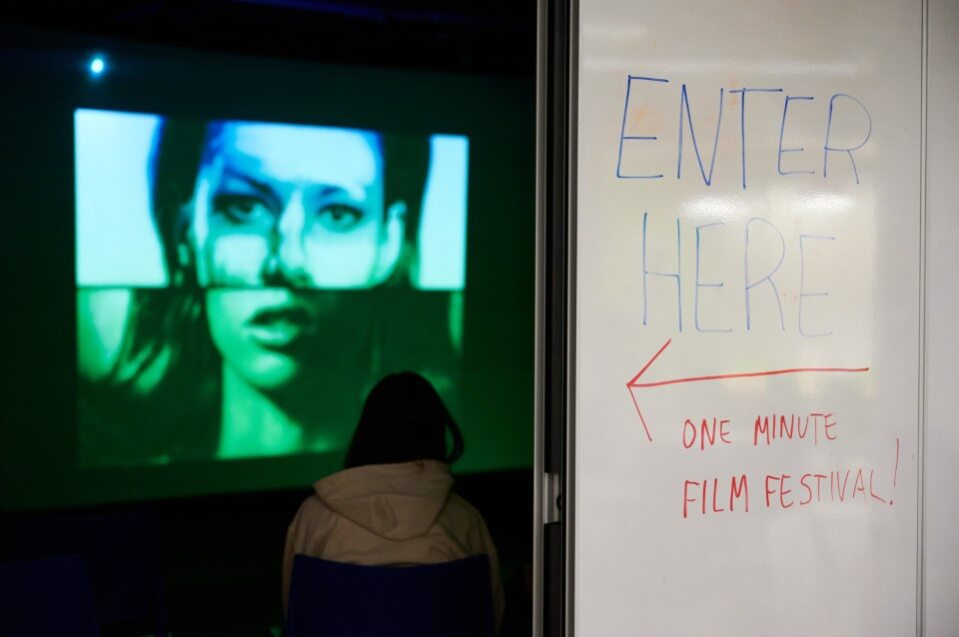Pitt’s Center for Creativity hosted its fourth annual One Minute Film Festival in the Understory in the Cathedral of Learning last Thursday. The festival featured 11 short films, all just one minute long, that ran on a 15-minute loop. Submissions were open to anyone affiliated with Pitt –– students and staff from Pitt’s main and branch campuses were all welcome to send in their one-minute films.
The festival included commercial breaks between films, but they weren’t modern advertisements seen on television today. These breaks featured vintage ads from the 1960s and ‘70, promoting products from pickles to cigarettes, contributing to the offbeat and experimental environment of the festival.
The movies spanned several genres, allowing a steady stream of audience members to pop in and out of the room to appreciate the festival. A mishmash of media including live action, collage film and stop motion claymation appeared in the screenings.
Erik Schuckers, manager of communications and programming at the Center for Creativity, helped create this festival to give participants the ability to collaborate with others.
“I was really interested in figuring out ways to encourage creativity that was collaborative, and I don’t think there’s anything more collaborative than making a film. Because oftentimes you get people who are interested in tech, and music, and acting, and writing, and all different kinds of creative endeavors together to make a film,” Schuckers said, “It seemed like such a natural fit for what we wanted to do at the Center for Creativity. We really want to encourage that kind of collaboration and experimentation among folks.”
The Center for Creativity offered programming to help participants in their filmmaking process. Events like coffee meetups with the program directors and workshops on how to use basic film equipment were available for anyone who wanted to take advantage.
Michaiah Johnson, a first-year student intending to major in English writing, said she learned valuable filmmaking lessons from creating her film “Spud,” which centered around a potato man she made during the Potatoesburgh event this past September.
“Less is more,” Johnson said. “You don’t need to show every tiny little thing as long as you can connect the things you are showing.”
Jacob Parayil, a junior computational biology major, submitted two films to the festival. He said the opportunity provided a chance for him to learn more about filmmaking. Parayil said he’s been interested in film since high school, and this experience allowed him to experiment with new ideas and techniques.
“You can think about it as practice as well. That’s the way I approached this, to see if I could do anything new or learn anything new while making film,” Parayil said. “And I did learn a lot about sound while doing this.”
However, the process of making a one-minute film didn’t come without its challenges. An audience may only see 60 seconds of a video, but a lot of work and thought went into telling the stories in such a short amount of time.
Parayil touched on these challenges, saying it was important to prioritize certain aspects of the film in order to meet the time requirement.
“I think the biggest challenge is the narrative. How do you tell a story in one minute?” Parayil said. “So even if you have a good idea in your mind, you have to limit certain things, maybe like the amount of twists, because you know there’s only so much you can do with one minute.”
Schuckers also commented on the challenges faced by filmmakers participating in this festival. He said the simplicity of these films can be deceiving.
“It’s so hard to tell a story, to capture a mood in 60 seconds. It’s a real challenge, I think, for a filmmaker,” Schuckers said. “In one way it’s very accessible and approachable. You feel like ‘I’m working within this time frame, so I don’t have to worry about a whole lot of the more technical aspects of filmmaking,’ but figuring out how to tell that story is a real challenge.”
Schuckers said the final product of filmmaking was fulfilling for creators and audiences.
“I think it’s really an interesting challenge,” Schuckers said. “But it’s also just so satisfying to both the filmmaker who then has a finished product and also to an audience that maybe wants to see a bunch of different stuff in a short period of time.”



